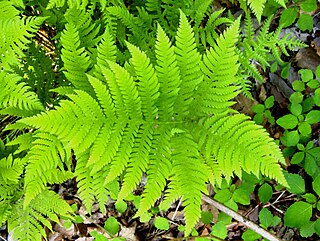
Phegopteris is a genus of ferns in the family Thelypteridaceae, subfamily Phegopteridoideae, in the Pteridophyte Phylogeny Group classification of 2016. They are known collectively as the beech ferns. Species are native to Asia, North America and Europe.

Pteris (brake) is a genus of about 300 species of ferns in the subfamily Pteridoideae of the family Pteridaceae. They are native to tropical and subtropical regions, southward to New Zealand, Australia, and South Africa, north to Japan and North America. 78 species are found in China. Some species of Pteris have considerable economic and ecological value, such as Pteris multifida, Pteris ensiformis, Pteris vittata can be used for ornamental purposes; as a hyperaccumulator, Pteris multifida and Pteris vittata can be used to control soil pollution.

Polypodiaceae is a family of ferns. In the Pteridophyte Phylogeny Group classification of 2016, the family includes around 65 genera and an estimated 1,650 species and is placed in the order Polypodiales, suborder Polypodiineae. A broader circumscription has also been used, in which the family includes other families kept separate in PPG I. Nearly all species are epiphytes, but some are terrestrial.

Cyrtomium is a genus of about 35 species of ferns in the family Dryopteridaceae, subfamily Dryopteridoideae, according to the Pteridophyte Phylogeny Group classification of 2016. Species are native to Asia, Africa, and the Pacific Ocean islands (Hawaii). It is very closely related to the genus Polystichum, with 2016 research suggesting it should be included in a clade sister to Polystichum s.s.

Arachniodes is a fern genus in the family Dryopteridaceae, subfamily Dryopteridoideae, in the Pteridophyte Phylogeny Group classification of 2016. A number of species in this genus are known as "holly ferns".

Bolbitis is a genus of ferns in the family Dryopteridaceae, subfamily Elaphoglossoideae, in the Pteridophyte Phylogeny Group classification of 2016.

Leptochilus is a fern genus in the family Polypodiaceae, subfamily Microsoroideae, according to the Pteridophyte Phylogeny Group classification of 2016 (PPG I).

Tectaria is a genus of fern in the family Tectariaceae, according to the Pteridophyte Phylogeny Group classification of 2016. Halberd fern is a common name for species in this genus.
Enterosora is a genus of ferns in the family Polypodiaceae, subfamily Grammitidoideae, according to the Pteridophyte Phylogeny Group classification of 2016 (PPG I). PPG I also recognizes the genus Zygophlebia, which more recent sources include in Enterosora. As of February 2019, many do not have formally published names in Enterosora and are retained here in Zygophlebia.

Argyrochosma is a genus of ferns known commonly as false cloak ferns. The genus is included in the Cheilanthoideae subfamily of the Pteridaceae. Species now in this genus were previously treated as members of related genera Notholaena or Pellaea but were segregated into their own genus in 1987. These ferns, of which there are about 20 species, are mostly native to the Americas, from North to South and including the Caribbean, while one species, A. connectens, is known from Sichuan, China. They are commonly found growing in cracks between rocks. Their leaves are generally shorter than 40 centimeters and have rounded bluish or grayish green segments. Often the lower surface of the segments is coated in a white dust, and the sporangia contain brown spores.
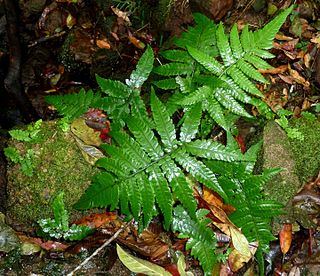
Deparia is a genus of ferns. The Pteridophyte Phylogeny Group classification of 2016 places the genus in the family Athyriaceae, although other sources include it within an expanded Aspleniaceae or Woodsiaceae.
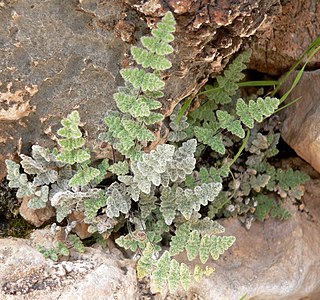
Cheilanthoideae is one of the five subfamilies of the fern family Pteridaceae. The subfamily is thought to be monophyletic, but some of the genera into which it has been divided are not, and the taxonomic status of many of its genera and species remains uncertain, with radically different approaches in use as of December 2019.

Doryopteris is a genus of ferns in the subfamily Cheilanthoideae of the family Pteridaceae.
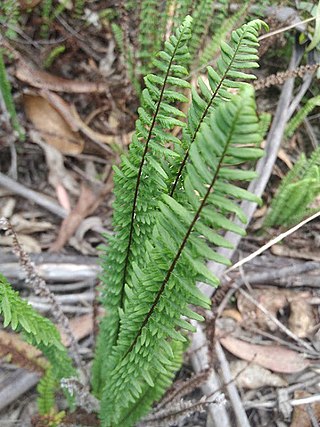
Adiantopsis is a genus of ferns in the subfamily Cheilanthoideae of the family Pteridaceae.
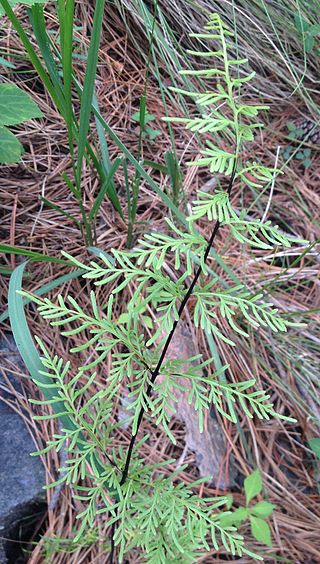
Mildella is a genus of ferns in the subfamily Cheilanthoideae of the family Pteridaceae. Species are native to Mexico, Central America and the Caribbean.
Oeosporangium is a genus of ferns in the subfamily Cheilanthoideae of the family Pteridaceae. The genus has not always been recognized. In the Pteridophyte Phylogeny Group classification of 2016 it was included in Allosorus. It was accepted by the Checklist of the Ferns and Lycophytes of the World as of January 2020. As circumscribed there, the genus is native to the Old World.

Hemionitis is a genus of ferns in the subfamily Cheilanthoideae of the family Pteridaceae. Its circumscription varies greatly in different systems of fern classification. In the Pteridophyte Phylogeny Group classification of 2016, it was one of more than 20 genera in the subfamily Cheilanthoideae, and was said to have five species. Other sources treat it as the only genus in the subfamily, and so accept about 450 species. With the restricted circumscription, species are native to tropical America.
Stegnogramma is a genus of ferns in the subfamily Thelypteridoideae of the family Thelypteridaceae in the Pteridophyte Phylogeny Group classification of 2016. Other sources sink Stegnogramma into a very broadly defined genus Thelypteris.
Pteridrys is a genus of ferns in the family Tectariaceae, according to the Pteridophyte Phylogeny Group classification of 2016 (PPG I).

Lepisorus is a genus of ferns in the family Polypodiaceae, subfamily Microsoroideae, according to the Pteridophyte Phylogeny Group classification of 2016 (PPG I).
















